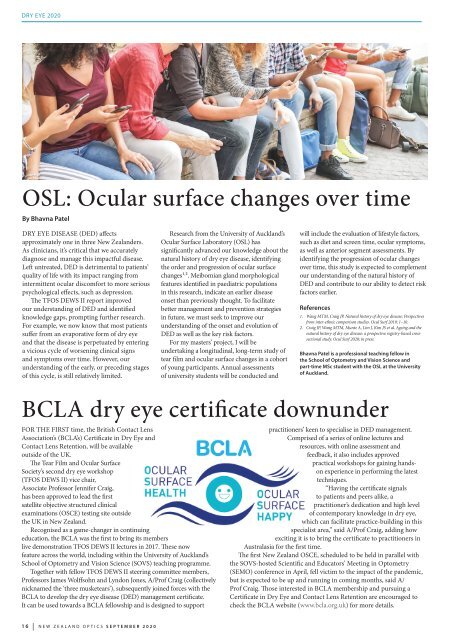Create successful ePaper yourself
Turn your PDF publications into a flip-book with our unique Google optimized e-Paper software.
DRY EYE <strong>2020</strong><br />
OSL: Ocular surface changes over time<br />
By Bhavna Patel<br />
DRY EYE DISEASE (DED) affects<br />
approximately one in three New Zealanders.<br />
As clinicians, it’s critical that we accurately<br />
diagnose and manage this impactful disease.<br />
Left untreated, DED is detrimental to patients’<br />
quality of life with its impact ranging from<br />
intermittent ocular discomfort to more serious<br />
psychological effects, such as depression.<br />
The TFOS DEWS II report improved<br />
our understanding of DED and identified<br />
knowledge gaps, prompting further research.<br />
For example, we now know that most patients<br />
suffer from an evaporative form of dry eye<br />
and that the disease is perpetuated by entering<br />
a vicious cycle of worsening clinical signs<br />
and symptoms over time. However, our<br />
understanding of the early, or preceding stages<br />
of this cycle, is still relatively limited.<br />
Research from the University of Auckland’s<br />
Ocular Surface Laboratory (OSL) has<br />
significantly advanced our knowledge about the<br />
natural history of dry eye disease, identifying<br />
the order and progression of ocular surface<br />
changes¹ , ². Meibomian gland morphological<br />
features identified in paediatric populations<br />
in this research, indicate an earlier disease<br />
onset than previously thought. To facilitate<br />
better management and prevention strategies<br />
in future, we must seek to improve our<br />
understanding of the onset and evolution of<br />
DED as well as the key risk factors.<br />
For my masters’ project, I will be<br />
undertaking a longitudinal, long-term study of<br />
tear film and ocular surface changes in a cohort<br />
of young participants. Annual assessments<br />
of university students will be conducted and<br />
will include the evaluation of lifestyle factors,<br />
such as diet and screen time, ocular symptoms,<br />
as well as anterior segment assessments. By<br />
identifying the progression of ocular changes<br />
over time, this study is expected to complement<br />
our understanding of the natural history of<br />
DED and contribute to our ability to detect risk<br />
factors earlier.<br />
References<br />
1. Wang MTM, Craig JP. Natural history of dry eye disease: Perspectives<br />
from inter-ethnic comparison studies. Ocul Surf 2019; 1–10.<br />
2. Craig JP, Wang MTM, Muntz A, Lim J, Kim JS et al. Ageing and the<br />
natural history of dry eye disease: a prospective registry-based crosssectional<br />
study. Ocul Surf <strong>2020</strong>; in press.<br />
Bhavna Patel is a professional teaching fellow in<br />
the School of Optometry and Vision Science and<br />
part-time MSc student with the OSL at the University<br />
of Auckland.<br />
BCLA dry eye certificate downunder<br />
FOR THE FIRST time, the British Contact Lens<br />
Association’s (BCLA’s) Certificate in <strong>Dry</strong> <strong>Eye</strong> and<br />
Contact Lens Retention, will be available<br />
outside of the UK.<br />
The Tear Film and Ocular Surface<br />
Society’s second dry eye workshop<br />
(TFOS DEWS II) vice chair,<br />
Associate Professor Jennifer Craig,<br />
has been approved to lead the first<br />
satellite objective structured clinical<br />
examinations (OSCE) testing site outside<br />
the UK in New Zealand.<br />
Recognised as a game-changer in continuing<br />
education, the BCLA was the first to bring its members<br />
live demonstration TFOS DEWS II lectures in 2017. These now<br />
feature across the world, including within the University of Auckland’s<br />
School of Optometry and Vision Science (SOVS) teaching programme.<br />
Together with fellow TFOS DEWS II steering committee members,<br />
Professors James Wolffsohn and Lyndon Jones, A/Prof Craig (collectively<br />
nicknamed the ‘three musketears’), subsequently joined forces with the<br />
BCLA to develop the dry eye disease (DED) management certificate.<br />
It can be used towards a BCLA fellowship and is designed to support<br />
practitioners’ keen to specialise in DED management.<br />
Comprised of a series of online lectures and<br />
resources, with online assessment and<br />
feedback, it also includes approved<br />
practical workshops for gaining handson<br />
experience in performing the latest<br />
techniques.<br />
“Having the certificate signals<br />
to patients and peers alike, a<br />
practitioner’s dedication and high level<br />
of contemporary knowledge in dry eye,<br />
which can facilitate practice-building in this<br />
specialist area,” said A/Prof Craig, adding how<br />
exciting it is to bring the certificate to practitioners in<br />
Australasia for the first time.<br />
The first New Zealand OSCE, scheduled to be held in parallel with<br />
the SOVS-hosted Scientific and Educators’ Meeting in Optometry<br />
(SEMO) conference in April, fell victim to the impact of the pandemic,<br />
but is expected to be up and running in coming months, said A/<br />
Prof Craig. Those interested in BCLA membership and pursuing a<br />
Certificate in <strong>Dry</strong> <strong>Eye</strong> and Contact Lens Retention are encouraged to<br />
check the BCLA website (www.bcla.org.uk) for more details.<br />
16 | NEW ZEALAND OPTICS SEPTEMBER <strong>2020</strong>

















